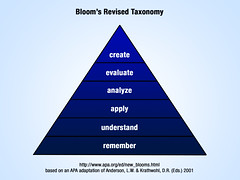I promised my colleague, Pam, I would explore blogging options for her Grade 9 students. This is the same group of students to whom I introduced to Diigo earlier in this Web 2.0 inquiry project. Due to their enthusiastic response to that first Web 2.0 tool, I want to make their introduction to blogging just as positive. Now that I am a seasoned blogger, with 17 (almost 18) posts published and widely read, I feel poised to pass on some advice. And just in case I am not as blog savvy as I profess to be, I did check in with a few trusted, academic sources for guidance.
Perhaps the most exciting aspect for me in regards to students getting into blogging, is that "blogging in its truest form has a great deal of potentially positive impact on students" (Richardson, 2010, p. 20). Richardson goes on to list six aspects of pedagogy which blogging can positively influence:
- Weblogs are truly a constructivist tool for learning;
- they expand the walls of the classroom;
- blogs archive the learning that teachers and students do, facilitating all sorts of reflection and metacognitive analysis;
- the Weblog is a deomcratic tool that supports different learning styles;
- the use of Weblogs can enhance the development of expertise in a particular subject; and,
- blogs can teach students the new literacies they will need to function in an ever-expanding information society (p. 27)
can be asked to begin using Weblogs for extended study and reflection on a topic. They could be asked to reflect and build on previous ideas, incorporate feedback from readers, synthesize reading s from a number of different sources, and advance new ideas or interpretation of the topic (p. 33).I am certain this group of students is up for the challenge, but I have a little confession to make. You see, I taught this group of students in Grade 6. I was their English teacher before I moved into the Teacher-Librarian position. I don't think I did a very good job of teaching them the skill of synthesis.

In Bloom's taxonomy, his classification system for the hierarchy of education goals, synthesis is one of the higher-order thinking skills.

In Bloom's revised taxonomy, which was developed by a team of psychologists, including Lorin Anderson, a former student of Benjamin Bloom's, synthesis is needed throughout the hierarchy.

So, how best to teach synthesis? To the right is a scaffold model I wish I had when I was a Grade 6 English teacher (Zawilinksy, 2009, p. 658).
It illustrates, in a simple step by step process, a plan for students to follow. I would expect initially, the end result to read fairly prescriptively, but if this had been introduced in Grade 6 and reinforced across the Middle Years Program (Grades 6-8), by the time Pam got this same group of students in Grade 9, in the GYP (Graduate Years' Program) they would be natural synthesizers. That much more prepared to segue into creating their own blogs and experiencing all that blogging can offer a learner. Sorry for the extra work you are going to have to do with this group, Pam!
References
Richardson, W. (2010). Blogs, wikis, podcasts, and other powerful web tools for classrooms. Thousand Oaks, CA: Corwin.
Zawilinski, L. (2009). HOT Blogging: A Framework for Blogging to Promote Higher Order Thinking. The Reading Teacher, 62(8), 650-661. doi: 1707486871
They aren't too bad at it! I don't think you have failed them at all. The model above is a similar model I have them use when having a group discussion about multiple texts, so I think they should be okay!
ReplyDeleteWell I know for certain they will be able to synthesize after English 9 with Mrs. McMartin!
ReplyDelete